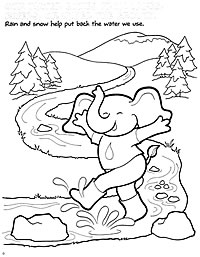Water Conservation - Four Phases of Water Conservation |
STAGE I : Voluntary Conservation
- Issue water shortage advisory
- Inform public of potential problem
- Request voluntary conservation
- Bulk water users implement voluntary conservation restrictions.
|
STAGE II: Mandatory Conservation Phase
- Issue water shortage alert
- Inform Public of the problem
- Set increased conservation goals
- Ban all non-essential users
- Bulk water users to implement mandatory water restrictions.
- Monitor & enforce when necessary a ban on all non- essential users
- Warning
- $100.00 fine
- Disconnection of service until Stage II is over
|
STAGE III: Emergency Phase
- Issue water shortage emergency
- Set increased conservation goals
- Continue restrictions
- Bulk water users to implement emergency water restrictions.
- Monitor all drought-related activities, especially with compliance and bans.
- Warning
- $100.00 fine
- Disconnection of service
|
STAGE IV: Rationing Phase
- Inform public of rationing phase
- Begin mandatory allocation of water.
(This may include disconnection of services to non-residential users.)
- Immediately reduce usage by at least 25%
- Require all bulk users to implement rationing water restrictions.
- Monitor & enforce when necessary a ban on non-essential users with:
- $200.00 fine
- Disconnection of service
|
| |
Listing of Non-Essential Water Uses |
-
Watering of lawns, shrubs, trees, ornamental plants etc.
Except by use of hand held container including a watering can or bucket
.
-
Seeding of lawns or planting of ornamental plants
.
-
Washing down of outside areas such as driveways, carports, outbuildings, etc.
.
-
Residential washing of vehicles including RV’s and ATV’s
.
-
Filling pools of any size or type, including “Kiddie” pools
.
-
Operation of ornamental pools, ponds, or fountains
.
-
Taking water from a hydrant for any reason other fighting fire
|
| |
Checking for Leaks |
If your bill seems high, and you think you are not using the water, then you should check for leaks in your plumbing. A few helpful hints are listed below.
-
Go to the water meter (located approximately 30 feet from the center of the road) in your front yard. Write the reading down. Then DO NOT USE ANY WATER AT ALL FOR AT LEAST ONE HOUR, and go back to the water meter and write the reading down. Compare the two readings. If the last reading is higher than the first reading water HAS gone through your meter….even though you have not “USED” any water…This means you have a leak.
-
Before you retire at night, put a few drops of food coloring in the back tank of your toilet. In the morning when you wake up, check to see if any color is in the bowl of the toilet. If so, then you have a leaking toilet. You DO NOT always hear a toilet leaking.
-
To determine if you have a leak in the line from the meter to the house, you need to first look at the meter to see if the leak indicator is turning (The leak indicator is a small triangle on the face of the meter this is usually red, white, or black) If it is then turn off the valve under your home so that no water is going into the home. Then go back and look at your meter, if the leak indicator is turning, then the leak is in your line if the leak indicator has stopped turning, your leak is inside the home.
If any of these situations occur, then you will need to get your repairs done as soon as possible. Even dripping faucets will add gallons to your water bill!!!
|
| |
Unrepaired Leaks Can Be Costly |
-
Leaking Faucet
100 drips per minute = 350 Gallons per month
.
-
Leaking Toilet
1/2 Gallons per minute = 21,600 Gallons per month
.
-
Watering Garden or Lawn
2 hours @ 5 Gallons per Minute = 18,000 Gallons per month
2 hours @ 10 Gallons per Minute = 38,000 Gallons per month
20-50% of water used lost to evaporation or run-off
.
-
Unattended Water Hose
9 hours @ 10 Gallons per Minute = 5,400 Gallons
|
| |
Water Conservation & Water Loss Statistics |
-
1 Bath = 42 gallons
-
30 Baths = 1,260 Gallons
.
-
1 Shower = 17 gallons
-
30 Showers = 510 Gallons
.
-
1 Load of Laundry = 45 Gallons
-
20 Loads of Laundry = 900 Gallons
.
-
1 Toilet flush = 7 Gallons
-
10 Toilet flushes per day = 2100 gallons per month
|



